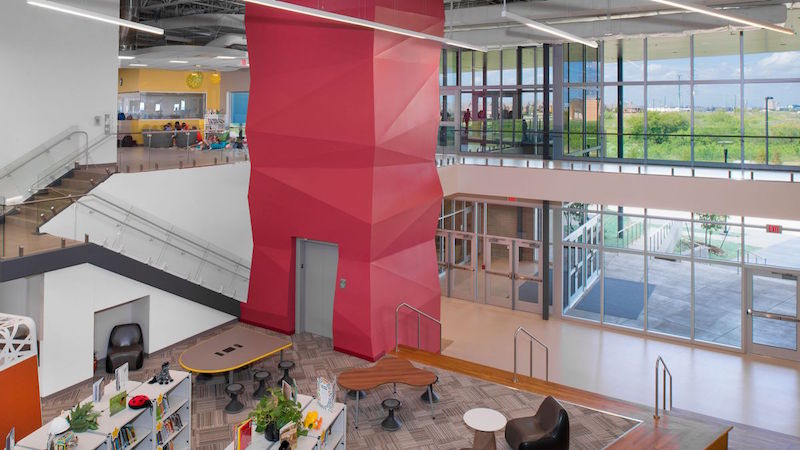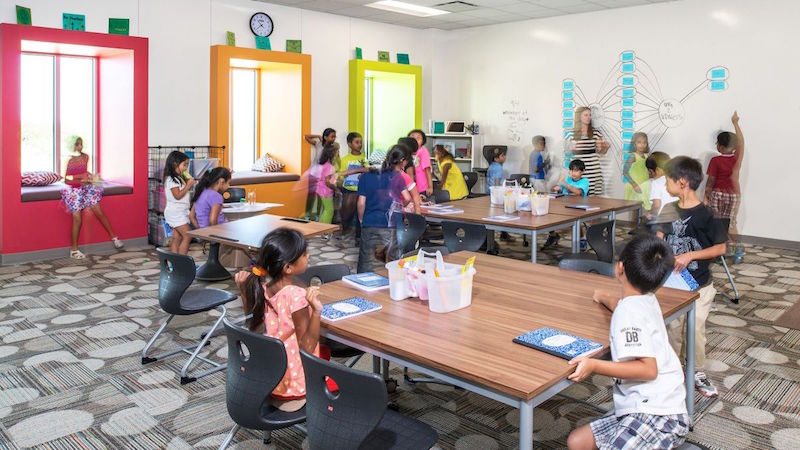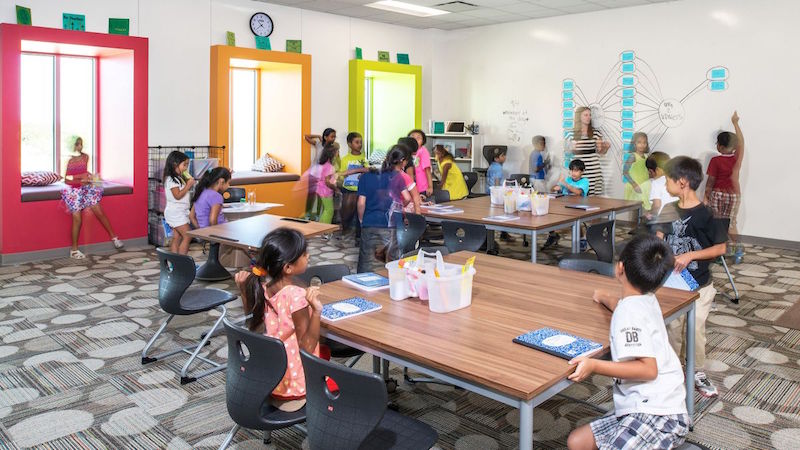There is a shifting era when it comes to energy today. That momentum can be appreciated when we see the vision for efficiency and renewables and understand the impact this shift can have on future generations.
In Alberta, the next generation has high expectations for climate leadership. It’s clear that we need to make good decisions today to meet the needs of our future. Students in schools today recognize that “climate change is a huge problem in everyday life” (Alberta Council for Environmental Education, 2016) and are responding through extra-curricular sustainability clubs and activities.
Today, students are advocating to participate in a culture of energy literacy that is integrated throughout all classrooms, from kindergarten to grade 12. Students want hands-on opportunities that give them practical experience. This can be delivered through the “bricks and mortar” of the school itself. Using the school as a tool for energy literacy, supported by curriculum integration, will deliver the societal changes necessary to be responsive to energy goals for 2030 and beyond.
We know that green schools can reduce emissions, especially when using tools like the LEED® rating system to benchmark performance for new schools. However, they also provide opportunities for energy and environmental education. Why is this important? Schools have a long lifespan of 50 or more years, educating not only our next generation of leaders but becoming de facto centers of our community and the ideal location to create a ripple of efficiency education for the community at large. How do we start the ripple? Through energy education and targeting net zero for new schools and aggressive energy targets for existing schools. Each day, 17 percent of Alberta’s population spends six or more hours in a school, providing an opportunity to deliver the benefits of energy efficiency and challenge the status quo.
 Lee Elementary School - Coppell, Texas - Net Zero School.
Lee Elementary School - Coppell, Texas - Net Zero School.
Conservation first
Through collaboration with energy providers, both fossil fuel and renewable; energy modelers; granting and funding agencies, such as Alberta Education; Alberta Infrastructure; school boards and trustees; school operators; and students, we can build a team to deliver net-zero schools and modernizations to achieve the expectations for climate leadership. Our first step is to benchmark energy use and set aggressive and realistic targets, including the capacity for renewables, and evaluate against that target throughout. The energy target will be best served with a simple compact that minimizes the area-to-envelope ratio and transitions that can leak energy, while orientating the building to take advantage of both passive design strategies and solar access for on-site solar renewables when possible. Keeping the building controls simple and responsive to users will help those users learn from the building and use the information to manage their energy and get the students involved. Once these strategies are thoughtfully considered and included, only then should we consider renewable energy. Conservation first is always the best strategy for any school—especially a net-zero school.
At Stantec, we have designed over 20 net-zero energy projects across North America, including 11 K-12 schools, and are able to leverage the success of those projects to supporting Climate Leadership goals in our home province—Alberta—and beyond.
What the students want
Alberta students have made three recommendations on curriculum:
- A framework of climate, environmental, and energy literacy should be integrated throughout ALL classes, from kindergarten to grade 12.
- Curriculum should encourage hands-on opportunities that give students practical experience as they make a difference.
- Teachers should be allowed enough time, support, and flexibility in their teaching so that students can learn about environment, energy, and climate change in their everyday lives.
Leveraging the bricks and mortar of the school buildings can assist to deliver these recommendations and support the additional recommendations made by students on school infrastructure:
- Engage students in reducing the consumption of energy and materials of their schools.
- Help the students learn how to produce energy and food in school.
- Create a fund that schools could apply to for relevant Climate Leadership projects.
We know that as much as 50 percent of the energy use in a building is contributed to the occupants and how they use and save energy. Using tools such as smart meters integrated with dashboard monitoring systems for energy production and energy consumption is a solid strategy to support climate leadership and educate tomorrow’s leaders. Most importantly, students are ready, willing, and able to take on the challenge to be stewards of their energy usage at school. That helps schools deliver a culture of sustainability and efficiency.
Once we have designed, constructed, and occupied and verified the achievement of the energy targets at a school and started a culture of energy literacy we have one last step in the process to net zero and a new generation of stewards for energy efficiency. That step? Celebrate!
 Lee Elementary School - Coppell, Texas - Net Zero School.
Lee Elementary School - Coppell, Texas - Net Zero School.
Tanya is inspired by connecting the natural world to the built environment, and creating energy conscious and efficient buildings. Her career spans from promoting sustainability through stakeholder engagement, workshops, speeches, and presentations; to developing and implementing strategic plans and advocating for practical sustainable practices within Alberta. She has been the Executive Director of the Alberta Chapter of the Canada Green Building Council (CaGBC) and spent 17 years engaged with the CaGBC’s annual sustainable building symposium.
More from Author
Stantec | Jul 18, 2024
Why decarbonizing hospitals smartly is better than electrification for healthcare design
Driven by new laws, regulations, tariffs, ESG goals, and thought leaders in the industry itself, healthcare institutions are embracing decarbonization to meet 2050 goals for emissions reductions.
Stantec | Jun 18, 2024
Could ‘smart’ building facades heat and cool buildings?
A promising research project looks at the possibilities for thermoelectric systems to thermally condition buildings, writes Mahsa Farid Mohajer, Sustainable Building Analyst with Stantec.
Stantec | Jun 8, 2024
8 ways to cool a factory
Whichever way you look at it—from a workplace wellness point of view or from a competing for talent angle—there are good reasons to explore options for climate control in the factory workplace.
Stantec | Apr 18, 2024
The next destination: Passive design airports
Today, we can design airports that are climate resilient, durable, long-lasting, and healthy for occupants—we can design airports using Passive House standards.
Stantec | Mar 18, 2024
A modular construction solution to the mental healthcare crisis
Maria Ionescu, Senior Medical Planner, Stantec, shares a tested solution for the overburdened emergency department: Modular hub-and-spoke design.
Stantec | Nov 20, 2023
8 strategies for multifamily passive house design projects
Stantec's Brett Lambert, Principal of Architecture and Passive House Certified Consultant, uses the Northland Newton Development project to guide designers with eight tips for designing multifamily passive house projects.
Stantec | Apr 10, 2023
Implementing human-centric design in operations and maintenance facilities
Stantec's Ryan Odell suggests using the human experience to advance OMSF design that puts a focus on wellness and efficiency.
Stantec | Jul 6, 2022
5 approaches to a net zero strategy that communities can start right now
Whether your community has started on a plan or is still considering net zero, now is the time for all of us to start seriously addressing climate change.
Stantec | Feb 14, 2022
5 steps to remake suburbs into green communities where people want to live, work, and play
Stantec's John Bachmann offers proven tactic for retrofitting communities for success in the post-COVID era.
Stantec | Feb 8, 2022
How gaming technology is changing the way we design for acoustics
Adding 3D sound from gaming engines to VR allows designers to represent accurate acoustic conditions to clients during design.
















